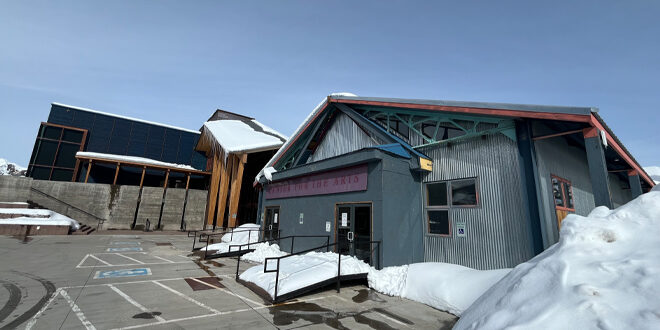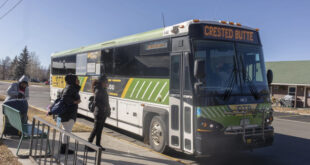Ownership a big talking point
By Mark Reaman
What should happen to the old Crested Butte Center for the Arts building located next to the new Arts Center? It is too dilapidated to utilize at the moment, and no one has the definitive plan or funds to make it useable any time soon.
With the idea to get way ahead of the game and start brainstorming ideas with community stakeholders, representatives of the Center for the Arts came before the Crested Butte town council on February 3 to begin the conversations of how to plan for a possible renovation of the building. That could include redefining the traditional partnership between the town and the Center and perhaps having the town give up its ownership of the building and transferring the title of the building to the non-profit organization.
The Center’s executive director Jillian Liebl and finance and development director Brett Henderson spent more than an hour with the council at a work session going over the current situation and possible paths forward.
“The original building is currently not useable,” Liebl directly stated to the council. “With the town’s Community Plan starting and the current MetRec planning underway, it feels like the right time to start a discussion over the building’s future.”
She said the building renovation has not been a priority for the Center’s board or staff. She said, however, that developing a good private-public partnership takes time and more than 30 community members have been polled recently about how to best use the building; “and we heard a ton of different things.”
While admitting there is not currently a pressing need for more art space since the new facility has openings particularly in the daytime and during off-season, that might not be the case in five years.
“The goal is to provide community arts and cultural experiences and increase building utilization while supporting other non-profits. We have been asking other organizations to share their ideas,” Liebl said. “We want to reduce the barriers to facility use and increase community events.”
Henderson said raising funds to renovate the building wouldn’t be easy. The public sector could help through taxes or grants and Liebl said that wasn’t likely to happen right now. Henderson said the Center is familiar with how private donations work but some combination of fundraising will have to be utilized to pay for improvements to the old building.
He said before undertaking a large renovation project the Center would want to build its cash reserves, retire the remaining $1 million in debt from construction of the new building, expand community programming and conduct a broad community engagement process. “These steps would probably take at least two or three years,” he said.
Currently the town owns both the Center buildings and the land. The Center leases the facilities for $1 per year under a 50-year lease with two 10-year extensions. The Center is responsible for insurance, maintenance and utilities which currently amounts to about $300,000 per year.
“From talking to other arts organizations, they need a combination of private and public support to succeed,” said Liebl.
“In discussing the situation with private donors, they would like to explore the current ownership structure,” said Henderson noting that some donors are not comfortable with the Center building being owned by the town.
“In your investigation with other groups, were there places where the ownership structure created problems?” asked mayor Ian Billick.
“It appears to me there haven’t been issues, but I can talk to art leaders in the other communities to focus on that more,” said Liebl.
Councilmember Mallika Magner said the Center has repeatedly come to the council over the decades asking to transfer ownership of the buildings. “It seemed the town councils always worried about not having ownership of the asset in the center of town and possibly having a bad outcome the town couldn’t control,” she explained. “There is always the question of why the Center would benefit with ownership when the town consistently supports the Center.”
“If you agree to that direction, you as the council would have to sell to the community the benefit of giving away such a big asset,” said town manager Dara MacDonald.
“My hope would be to find ways to safeguard the community if some sort of title transfer is done,” said Henderson.
Billick suggested there could be legal measures to protect the town’s interests in the long run. “It would have to be thought through carefully and those controls would be critical,” he said.
Councilmember John O’Neal asked what the problem from private donors was about town ownership of the building. Henderson explained they wanted to be assured of helping the Center in perpetuity. O’Neal pondered if an alternative like a 100-year lease would ease some of the concern.
Councilmember Gabi Prochaska asked how much retaining town ownership of the buildings would discourage private donors. Henderson couldn’t provide a definitive number but said “if we had title tomorrow it would unlock $2 million right away.”
Billick stated that ownership control should not be the prime issue but rather the council should articulate the problem it wanted to solve and head there.
Prochaska said she wanted the town and building protected 50 years into the future. Town attorney Karl Hanlon said deed restrictions could be crafted to do that, but the stickiest future concern would probably be if the town ended up having to deal with lenders who held the building as collateral for some reason.
“Once somebody owns something, it’s really hard to get back,” said Magner. “The town could be in a spot where it perhaps doesn’t have the money at a certain time for even a first right of refusal. Lawyers will say it is easy to draft documents around things but that is why there are lawsuits.”
“We’re not even sure the current lease doesn’t allow them to do some things we might not like,” said Billick. “Again, what is the problem we’re trying to solve?”
The council wasn’t ready to sign over the building title immediately and had several questions about the old building’s future.
“Have you thought about adaptable spaces as the needs of the community changes?” asked councilmember Anna Fenerty.
“There are a lot of community needs and we are looking at multi-use spaces that can change over time,” said Henderson.
“We want to avoid it being so multi-purpose that it isn’t good for anything,” added Liebl. “Then it becomes like a puffy rain jacket that just doesn’t work for anything.”
“What about housing or spaces for artists?” said Fenerty.
Liebl said housing is currently not permitted in Crested Butte’s P-zones. “But there have been conversations about creative spaces,” said Henderson.
Fenerty reiterated that the building could address other, less artistic needs like a future post office, senior center or childcare space.
“We are super open to all ideas,” emphasized Liebl. “This is the early idea stage.”
“Is the Center currently struggling to finance itself?” asked Magner.
“We’re not struggling. We’ve managed to pay down $4 million in debt, but we don’t have the cash cushion we would like,” explained Liebl. “Like other non-profits, two-thirds of our budget depends on private funding.”
“The remaining $1 million in debt is still an anchor for us,” said Henderson. “We can fly higher when that is dropped.”
“Future collaboration is critical and that might mean some loss of control for the town, but the devil would be in the details,” said Billick who also encouraged financial partnership opportunities with the MetRec district.
“We would love to have a decision point with the ownership options from the town sometime this year,” said Liebl.
“That would help us develop a long-range plan,” added Henderson. “As community leaders we are all trying to get ahead of the issue.”
The council tasked the Center representatives to come back with more information from other Centers in similar communities.
“Maybe the town has to be a better partner,” said O’Neal. “What does that look like from the Center’s perspective?”
“This open conversation is a great first step,” replied Henderson.
“We’re excited and really want to redevelop the old building,” concluded Liebl. “It will just take time and money.”
Councilmembers said they appreciated the early conversation on the matter, and they hope to continue the conversation by the late spring. Billick also said the council hopes to hear public feedback on the issue.
 The Crested Butte News Serving the Gunnison Valley since 1999
The Crested Butte News Serving the Gunnison Valley since 1999


